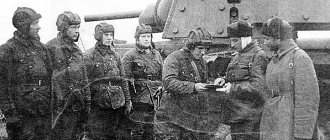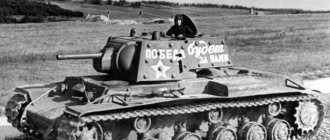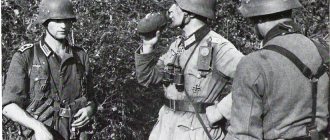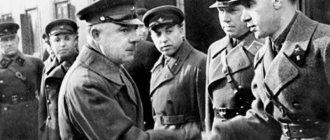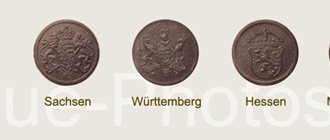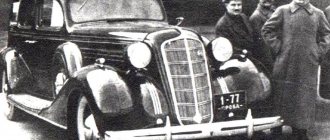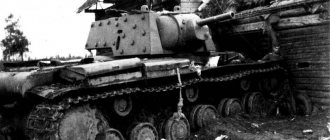War is a difficult test not only for soldiers who are daily face to face with death, but also for army commanders who are vested with power and are not obliged to come into direct contact with the enemy. However, both of them end up in the hands of the enemy. They used to avoid talking about the fate of German generals who were captured during the Second World War. In the military, refusal of higher ranks from armed struggle is considered an offense that violates the code of officer honor.
Cartridges and potassium cyanide
On December 24, 1947, border guards in the Soviet zone of occupation of Germany detained a man with dangerous luggage - an elderly man trying to get into the British zone with 19 live cartridges for a 6.35 mm pistol. After his arrest, the German wanted to commit suicide, but border guards discovered potassium cyanide under the lining of his hat in time. It was not the first time that we managed to get the detainee to talk - he turned out to be Wehrmacht General Rudolf Schmidt, commander of the 39th Corps of Army Group Center. Schmidt took part in the capture of Belarus, the Battle of Smolensk and the battles near Leningrad. He was soon taken to Moscow and in 1952 he was sentenced to 25 years in the camps for war crimes. He was one of the few who honestly admitted his atrocities: the abduction of Soviet citizens into slavery in Germany, the organization of punitive operations against partisans, the approval of death sentences...
Schmidt is the last Wehrmacht general arrested by the Soviet Union. The point is not that he skillfully hid, but rather, on the contrary, his own carelessness (otherwise he would have been captured back in 1945 at the front). In 1943, Schmidt was arrested in Orel by the Nazis themselves for letters to his brother, in which he criticized Hitler and other NSDAP leaders for incompetent troop management, and also talked about plans to flee the army. Soon, the general's brother was sentenced to death for spying for the French Resistance (to avoid execution, the brother poisoned himself in prison). Schmidt himself was dismissed from the army, but was still released thanks to the intercession of his colleagues - the case was presented as if his mind was clouded due to a “painful condition.” Schmidt lived in Berlin and Weimar, bought and wrote patents for the production of alcohol, oil and syrup from chestnuts and acorns, and in the Soviet zone in 1947 he came to his friends for personal belongings, among which were those same cartridges.
R. Schmidt. (ritterkreuztraeger.blogspot.com)
Mentality and number of prisoners
While 83 Soviet generals were captured during the war, there were almost 5 times more German generals. And they behaved completely differently there. From the very first days, the overwhelming majority of Germans agreed to work with the authorities , participated in propaganda events, joined the anti-fascist Officers' Union, and some (Seidlitz, Korfes, Müller) even proposed the creation of a liberation army from German prisoners of war.
This cooperation took on a massive scale after August 14, 1944, the date of the failed assassination attempt on Hitler and the failed coup attempt. The number of captured generals grew every year:
- 1943 - 32 people led by Field Marshal Friedrich Paulus surrendered;
- 1944 - 44 generals of the Wehrmacht, artillery, Panzerwaffe;
- 1945 - 300 prisoners of all branches of the military (Navy, Luftwaffe, SS, police, Allies, civilian officials who received the rank of general for outstanding services to the Reich).
While our military leaders were usually captured wounded or unconscious, the Germans preferred to surrender without resistance, laying down their arms according to all the rules of Prussian etiquette.
According to the certificate of Colonel P. S. Bulanov, who held the post of head of the prison department of the Ministry of Internal Affairs in 1956, 376 generals were in Soviet captivity, of which:
- 18 were executed as war criminals;
- 81 died in the camps;
- 277 were released and returned to their homeland.
The winners are judged
Schmidt's "anti-Hitler" history did not free him from responsibility for the atrocities committed by the troops under his command. Other war criminals had even less hope of acquitting themselves. In total, the Red Army captured 376 German generals (for comparison, 72 Soviet generals were captured by the enemy during the war years), including three field marshals: the “chief prisoner of Stalingrad” Friedrich Paulus, Ewald von Kleist and the “bloody dog” Ferdinand Schörner. Most of them, like Schmidt, understood that investigations into their own actions and the actions of their subordinates could not be avoided.
The trials of Wehrmacht and SS officers began even before 1945. In 1943, J.V. Stalin, on the pages of the newspaper Pravda, promised Soviet citizens severe retribution for Nazi criminals; in the same year, open trials of captured Wehrmacht officers and SS men were held in Krasnodar and Kharkov. In 1945 - 1949 Trials took place in the cities most affected by the war: Smolensk, Bryansk, Leningrad, Minsk, Nikolaev, Kiev, Velikiye Luki, Riga, Sevastopol, Chernigov... Military tribunals, in accordance with international law, then convicted 222 people, including 35 generals. The investigation collected so much evidence of guilt that almost all the defendants confessed to numerous crimes. They were usually tried in the city near which the accused committed their crimes. Thus, the case of Colonel General Erwin Jenecke was dealt with in Sevastopol (his 17th Army committed atrocities in the Kuban and Crimea) and the case of General Heinrich Remlinger - in Leningrad (his subordinates exterminated people near Pskov and Leningrad).
Defendants at the Riga trial of 1946 (vkpb.org)
The trials ended in 1952, and they ultimately sentenced 41 German generals to death by hanging (they were hanged in the squares of the same cities where the trials took place). Dozens more received 25-year sentences in camps or prisons, or less often, hard labor. Among these prisoners were Field Marshals von Kleist and Schörner. The third field marshal - Paulus - collaborated with the USSR, acted on the side of the prosecution in Nuremberg and therefore was kept not as a criminal, but as an honorary prisoner with privileges: dietary food, the right to correspondence, beer on holidays, the opportunity to write memoirs, a dacha near Moscow; in 1953, Paulus was returned to Germany, and they also gave him a villa in Dresden.
Kleist's fate was less favorable - he died of heart failure due to nephritis. Buried in Vladimir. Many Nazi criminals served time in the Vladimir Central and ended their days there: for example, the last commander of the defense of Berlin, General Helmut Weidling, an expert on Russia, General Oskar von Niedermayer (considered himself an opponent of the war with the USSR, in the 1920s he worked in Moscow for several years ) and others.
Defendants at the Leningrad trial of 1945 (Wikimedia Commons)
General Seydlitz-Kurzbach
Seydlitz-Kurzbach and Paulus in Stalingrad
Walter von Seydlitz-Kurzbach was captured by Russians in 1942. The military leader did not demonstrate fundamental disagreement with the Bolsheviks and immediately gave the go-ahead to cooperate with the special forces. Subsequently, it was he who led the aforementioned “Free Germany”. Then Seydlitz-Kurzbach put forward the initiative to create battle groups from captured Germans to fight the Nazis.
Captured German General Seydlitz-Kurzbach addresses those surrounded in the Cherkassy cauldron
After the fall of the Third Reich, the general had to stay and live in the Land of the Soviets. Seydlitz repeatedly petitioned for his return to Germany, but was always refused. In 1950, he was taken into custody and put in solitary confinement. In 1955 he was released, and then was sent home. This turn in his fate was helped by Chancellor Adenauer’s visit to the USSR.
Political decisions
Kleist, by the way, could have left prison much earlier than after 25 years - if not for his illness. Field Marshal Schörner, thanks to the ups and downs of the Cold War, practically escaped retribution: even the German generals did not favor him for his cruelty: murderer, “bloody dog,” “military Goebbels,” gendarme, whatever they called him (and quite rightly). In the USSR, the ardent Nazi and Hitler's favorite was pardoned at his request, released in 1955 and offered to live in the GDR, as well as a villa, a car and a position at the military academy. The only condition is to publicly support the policies of the GDR. However, Schörner refused and went to Germany, and no obstacles were put in his way. In Germany, Hitler's field marshal was sentenced to 4.5 years in prison for unjustified executions of German soldiers. “A monster in uniform,” Schörner died in 1973 in Munich, where he met Hitler back in the early 1920s.
Note: Perhaps a more surprising incident than with Schörner and Paulus occurred only with the captured General Vinzenz Müller. Having been captured in 1944, Müller immediately agreed to participate in the anti-fascist organizations of prisoners, spoke on Radio Free Germany and wrote in the newspaper of the same name. For this, he was released in 1948, and after that he was made a general of the National People's Army (GDR). In the 1950s, Müller headed the General Staff of the NPA and served as Deputy Minister of Defense.
In 1955 - 1956 Not only Field Marshal Schörner, but also other war criminals and prisoners were released to Germany. None of those sentenced to 25 years of imprisonment “served” to the end: someone died in captivity, and the rest returned home. This happened after the visit of German Chancellor K. Adenauer to the USSR and his meeting with N. S. Khrushchev in October 1955 - the parties established diplomatic relations between the countries, as a kind gesture, the Soviet Union repatriated more than 14 thousand convicted Germans and returned prisoners. Among the last captured generals returned to Germany was the same Rudolf Schmidt. Like almost everyone else, he later lived quietly in Germany - at that time the authorities of the republic rarely pursued war criminals and generally initiated any investigations.
At the Kiev trial of 1946 (rg.ru)
Returning captured generals did not have to seriously complain about the conditions of detention in the USSR. Until 1945, they were even allowed to wear uniforms and insignia, they were not prohibited from writing to relatives and going for walks, they received rations with a higher calorie content than ordinary prisoners, as well as cigarettes and matches; they were allowed to garden, read... Wehrmacht generals (not convicted) were kept in Krasnogorsk, in the Spaso-Evfimievsky Monastery in Suzdal, in the Ivanovo region. Even high-ranking war criminals were treated with restraint by NKVD officers. The same Schörner, when he returned to Germany, could only remember the following “tortures and abuses”: body searches, placement in a punishment cell for half a day during the investigation, night calls for interrogation, permission to use the toilet only in the morning and evening, as well as the need to “clean yourself toilets." Soviet retribution turned out to be much less cruel than Nazi crimes.
Camp rules
The conditions in which the generals were kept were quite comfortable. The rest house of the Central Committee of the Railway Workers' Trade Union in the village of Cherntsy, located in the Ivanovo region .
There was no compulsory work, but if desired, one could work in the garden, the products from which supplemented the prisoners’ diet. Patients were given a supplementary ration with an increased portion of meat and butter. During the existence of the camp there was not a single attempt to escape or riot.
Rare protests were caused by everyday complaints (poor service in the dining room, lack of food supply, power outage, etc.).
